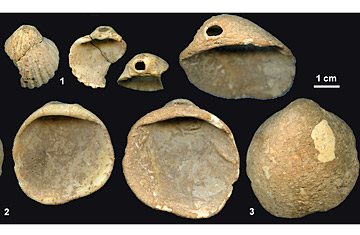
Artifacts from the Cueva de los Aviones and Cueva Antón sites in Spain
Here's something you probably know: Neanderthals did not shop at Tiffany's. Here's something you probably don't: They nonetheless had impressive taste in jewelry, a fact that makes them a bit more intelligent than we thought — and humans a bit less special.
Between 40,000 and 30,000 years ago, Neanderthals — the hulking, thick-skulled species closely related to us — vanished from the earth, leaving us as the last humans standing. Nobody knows for sure what happened to them. Maybe we killed them off. Maybe we outcompeted them for scarce resources during the waning decades of the last Ice Age. Or maybe — though this is still hotly debated — we simply mated with them, which would mean we all have a bit of Neanderthal in us.
Whatever wiped them out, though, a consensus has been growing for years that it wasn't because the Neanderthals were short on raw intelligence. Their brains were as big as ours, and we've known for a century that they buried their dead just as we do; they also made stone tools, and theirs have been found in association with painted shells and other baubles. But maybe there was a subtler difference in our brains. Some paleoanthropologists have said that when our ancestors made jewelry, for example, it implied the ability to think symbolically — that the adornment represented individuality or status. If the Neanderthals did this, according to the idea, they were just imitating the modern humans who co-existed with them in Europe, sort of like a child playing dress-up.
But a new paper in Proceedings of the National Academy of Sciences makes that argument a lot harder to sustain. João Zilhão of the University of Bristol, along with several colleagues, has uncovered Neanderthal jewelry from two caves in southern Spain dating to about 50,000 years ago. "This," says Zilhão, "is 10,000 years before modern humans arrived. There is no question that Neanderthals are their makers."
The objects in question consist mostly of seashells, many of them pierced, with bits of pigment on them. It's always possible that the pigment was simply present in the soil where the shells ended up — but then you'd expect the coloring to be widespread. In fact, it's specific to certain shells. Beyond that, several shells contain different pigments that were clearly mixed together deliberately. In some cases, the pigments were of a type that is only known to have been used (in ancient Egypt, for example, so we have actual records) for body painting. "There's a sector of the profession," says Zilhão, "that's been healthily skeptical of our work in the past. But in this case, the problems of dating don't exist."
Nor are jewels, body paint and burials the only evidence for Neanderthal ingenuity. Several years ago, German scientists published a study saying that Neanderthals were manufacturing tarlike pitch out of tree resins, which they then used to affix stone points to wooden shafts. "This isn't an easy thing to do," says Zilhão. "It involves several hours of processing at 400 degrees. These guys made the first artificial raw material in the history of mankind."
All this leaves the question of how Neanderthals got their thick-as-a-brick reputation in the first place. "The original idea of Neanderthal dumbness," says Erik Trinkaus, a paleoanthropologist at Washington University (in St. Louis, Mo.), "emerged around the turn of the last century." People back then had a stake in believing that modern humans were the pinnacle of evolution, and because Neanderthals were clearly different physically, they had to be inferior." The new work by Zilhão and his colleagues, says Trinkaus, "is just one more important piece in that puzzle that says these people may have looked different, but behaviorally, cognitively and socially, they were not all that different from you and me." That includes their taste for a little bit of bling.
